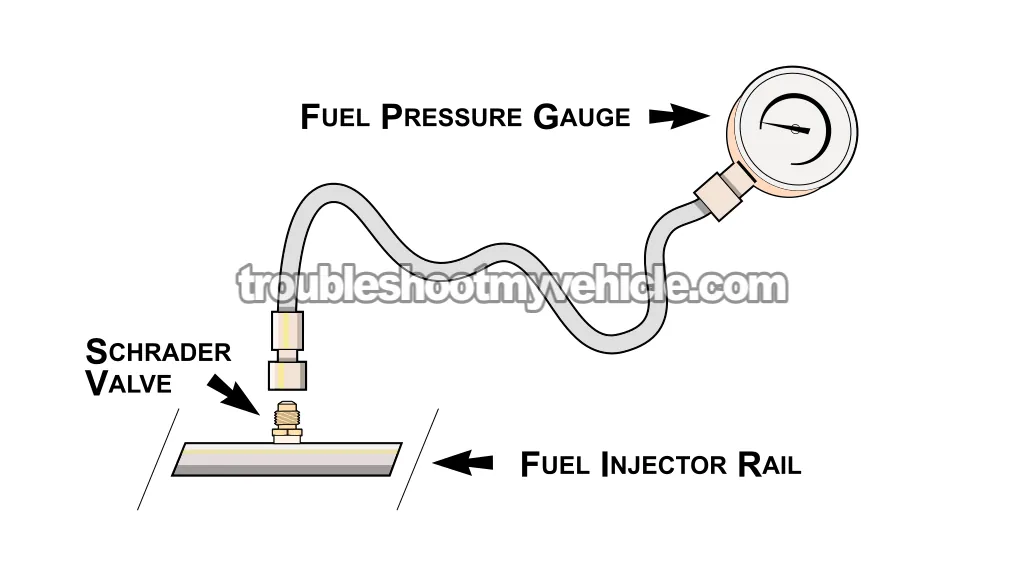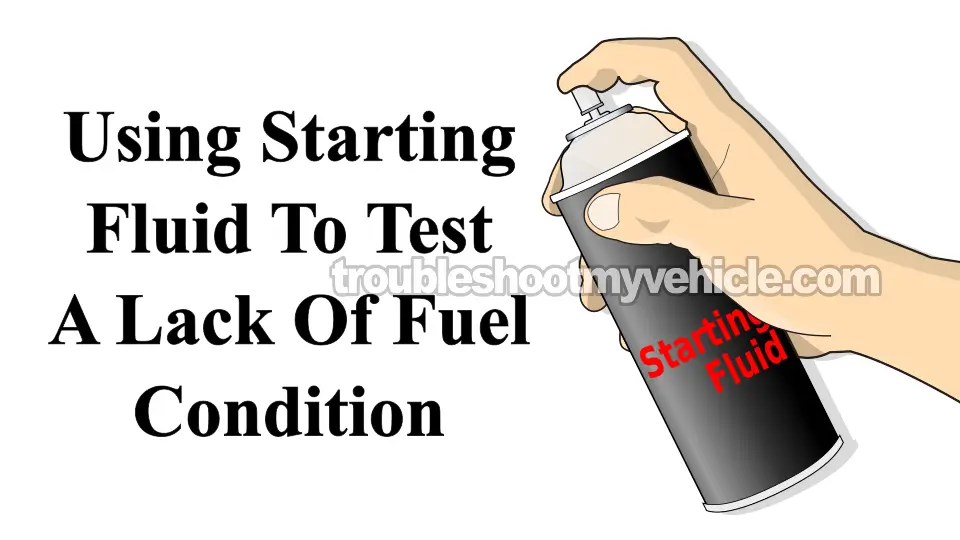
In this guide, I'll walk you through how to test fuel pressure step by step using a fuel pressure test gauge —and also explain how to perform the Starting Fluid test as a quick first check.
You'll learn how to interpret the results and determine whether your fuel pump is weak, failing, or completely dead.
So whether your 2006–2009 4.7L Dodge Ram pickup is hard to start, lacks power, or won't start at all, these tests will help you figure out if the fuel pump is to blame.
Contents of this tutorial:
APPLIES TO: This tutorial applies to the following Dodge Ram pickups:
- 4.7 V8 Dodge Ram 1500 Pickup: 2006, 2007, 2008, 2009.
WIRING DIAGRAMS:
- Fuel Pump Circuit Wiring Diagram (2006-2008 4.7L V8 Dodge Ram Pickup).
- Fuel Pump Circuit Wiring Diagram (2009 4.7L V8 Dodge Ram Pickup).
ENGINE NO-START DIAGNOSTICS:
2002-2005 FUEL PUMP TESTS:
Symptoms Of A Bad Or Failing Fuel Pump
In the 2006–2009 4.7L Dodge Ram pickup, fuel pump failures generally fall into two main categories: a complete shutdown or a gradual loss of pressure output. Both can lead to serious engine performance issues —or keep the engine from starting at all.
- Dead pump: The pump doesn't engage when the key is turned —no fuel flow, no-start-up.
- Weak pump: The engine gets just enough fuel to run, but pressure is too low for proper operation.
When the pump is still running but not delivering the pressure your engine needs, you'll likely see symptoms like:
- Unsteady idle —The engine may shake at idle, whether in Park or Neutral.
- Hard starts —It takes several (long) seconds of cranking before the engine finally fires up.
- Sluggish acceleration —The truck feels like it's struggling when you step on the gas.
- Backfires under load —Especially when climbing hills or even just accelerating gently.
- Lean fuel mixture codes —DTCs like P0171 and P0174 often point to low fuel pressure leaning out the air/fuel mixture.
If you're chasing a no-start or poor performance issue on your 4.7L V8 Dodge Ram pickup, testing fuel pressure should be one of the first steps. It's fast, easy, and can save you from replacing parts you don't need.
Fuel Pressure Specifications
| 2006-2009 | |
|---|---|
| 4.7L | 59 ± 5 PSI (Key On Engine Off -Scan tool fuel pump activation) |
Where To Buy A Fuel Pressure Test Gauge
A fuel pressure gauge is one of those tools you definitely want and need to have in your tool box.
You can find fuel pressure test gauges at most auto parts stores or online. The following kits offer solid value and are compatible with the fuel system on your 2002–2005 4.7L V8 Dodge Ram pickup:
Disclosure: As an Amazon Associate, I earn from qualifying purchases. If my tutorials help you, using these links is an easy way to support the site at no extra cost to you. Thank you!
TEST 1: Checking Fuel Pressure With A Fuel Pressure Gauge

To check the condition of the fuel pump, you'll need to connect a fuel pressure gauge to the Schrader valve found on the passenger-side fuel rail —this gives you direct access to the fuel line pressure.
Once the gauge is connected, the repair manual "says" you've got to activate the fuel pump with a bidirectional scan tool. If you have one, man, that's awesome —use it to check the fuel pump pressure.
If you don't have one, no big deal —we can still check the fuel pump's pressure output.
In the instructions below, I'm gonna go over the three testing setups you can use: engine running, engine cranking, and using a scan tool to activate the fuel pump.
These are the test steps:
- 1
Place a shop towel over the Schrader valve. This helps catch any fuel that might escape during the next step.
- 2
Attach your fuel pressure gauge to the Schrader valve on the passenger-side rail. Hand-tighten it only.
- 3
Ask a helper to cycle the key ON and OFF a few times (without cranking the engine) while you keep an eye on the gauge.
Look for leaks at the gauge fitting and re-tighten by hand if necessary.
KOER Test —Engine Starts And Idles
- 4
Start the engine and let it settle into idle.
- 5
Take note of the pressure reading on the gauge.
It should fall within the normal range of 44–54 PSI.
Cranking Test —Engine Won't Start:
- 4
Have your helper crank the engine for a few seconds.
- 5
Check the gauge after the key is released.
The expected pressure is between 59 ± 5 PSI.
KOEO With A Scan Tool —No Matter The Engine's Condition
- 4
Plug your scan tool into the diagnostic port (under the dash).
- 5
Turn the ignition ON, but don't start the engine.
- 6
Use the scan tool's output controls to activate the fuel pump.
- 7
Watch the pressure gauge:
The fuel system should pressurize to 59 ± 5 PSI if the pump is working properly.
This is what that result actually means:
CASE 1: Gauge shows 0 PSI. This confirms that the fuel pump isn't sending fuel to the fuel injectors behind the engine's no-start issue.
If all 8 COP ignition coils are sparking, you can conclude the fuel pump is bad and needs to be replaced.
This tutorial explains how to test the ignition coils:
CASE 2: Fuel pressure is lower than it should be. This suggests the pump is running, but it's too weak to meet engine demands. It's only a matter of time before it fails completely, so replacement is the smart move.
CASE 3: Fuel pressure is within the proper range. That's exactly what you want to see —your pump is doing its job.
If your Dodge Ram still won't start —this in-depth tutorial will walk you through what to check next:
TEST 2: Using Starting Fluid To Confirm Lack Of Fuel

One of the quickest ways I've found to check if a no-start problem is caused by lack of fuel is with starting fluid —it's a go-to first test in my diagnostic routine.
The process is straightforward: spray some starting fluid into the throttle body, crank the engine, and see what happens. If the engine starts momentarily and then stalls, it's a strong clue that fuel delivery is the issue.
While not a precision method, it's a fast, reliable way to narrow things down before diving into more involved testing.
NOTE: To avoid misdiagnosis, confirm that all 8 ignition coils are firing spark —no spark means this test won't tell you much.
SAFETY TIP: After spraying the starting fluid, always reinstall the air duct before cranking the engine (no need to clamp it down). This prevents unexpected backfires from startling you or causing injury.
Here's how to do it:
- 1
Loosen and lift the air duct off the throttle body. No need to remove it completely —you'll need it again in a moment.
- 2
Manually open the throttle plate and spray starting fluid into the intake bore.
Once done, reposition the air duct over the throttle body —no need to tighten clamps. - 3
Clear the engine bay and crank the engine. Make sure your hands and tools are out of the way before turning the key.
- 4
You'll see one of two outcomes:
1.) The engine fires up briefly, then shuts off.
2.) The engine just cranks but never starts.
Here's how to read your results:
CASE 1: Engine starts momentarily, then stalls. That's a solid indicator that fuel delivery is the problem —the pump isn't supplying enough fuel to keep the engine running.
Your next move is to verify fuel pressure with a gauge. Head to: TEST 1: Checking Fuel Pressure With A Fuel Pressure Gauge.
CASE 2: Engine doesn't start at all. This usually points away from a fuel issue and toward ignition system, sensor issues, or compression problems.
Even so, starting fluid isn't a definitive test. For a conclusive result, confirm fuel pressure with a gauge: TEST 1: Checking Fuel Pressure With A Fuel Pressure Gauge.
More 4.7L V8 Dodge Ram Pickup Diagnostic Tutorials
I've written quite a few tutorials for the 4.7L V8 Dodge Ram pickup. You can find them in this index:
Here's a small sample of the tutorials you'll find in the index:
- How To Test For A Blown Head Gasket (2002-2009 4.7L V8 Dodge Ram Pickup).
- How To Test The Fuel Injectors (2002-2009 4.7L V8 Dodge Ram Pickup).
- How To Test The CKP Sensor -P0320, P0335, P0339 (2002-2010 4.7L V8 Dodge Ram Pickup).
- How To Check For Vacuum Leaks With Carb Cleaner Spray (2002-2009 4.7L V8 Dodge Ram Pickup).

If this info saved the day, buy me a beer!




